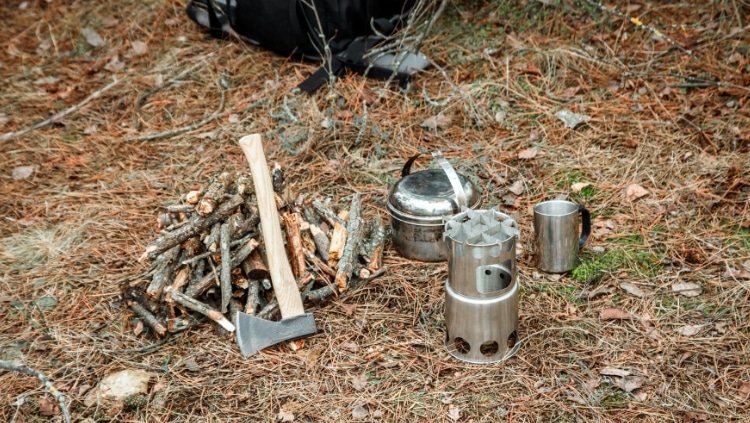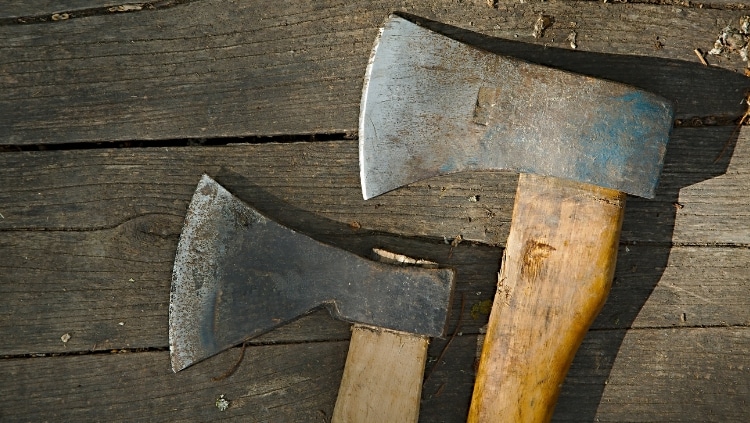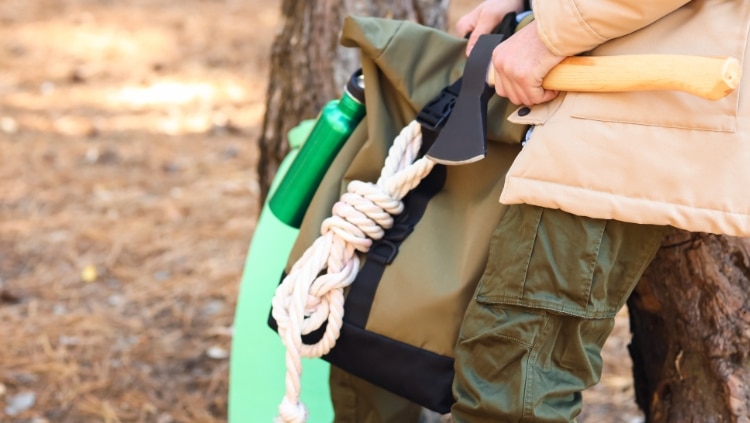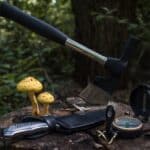Humans started making tools millions of years ago, with the first axe showing up on record 1.8 million years ago. Every moment since then, there have been people using axes and hatchets for various uses across the globe.
The difference between an axe and a hatchet can be hard to distinguish. So if you’re in the market for a blade that can chop, you’re probably wondering whether you should get a hatchet or an axe. And it would be nice to know why.
Axes are much larger with handles that are 20-36 inches long. Hatchets are small with handles around 12-18 inches long. An axe is better for splitting wood and larger jobs like felling trees, while a hatchet is better for small, more tactile jobs like preparing kindling for a fire.
But there’s even more to it than that one simple answer.
The Difference Between a Hatchet and an Axe
The hand axe is among the first stone tools that archaeologists discovered. Modern axe or hatchet designs likely evolved from these early tools resulting in a spectrum of handle lengths, blade types, and applications.
From afar, an axe and a hatchet seem incredibly similar tools to get the same job done. However, when it comes down to it, these two tools have significant design details that make each one a better choice for different jobs.
| Weight | Handle Length | Primary Uses | Blade | |
| Axe | 3+ pounds | 20-36 inches | Splitting wood, felling trees | Slight taper (wedge shape) |
| Hatchet | 1-3 pounds | 12-18 inches | Carving, preparing kindling | Smaller with a significant taper (V shape) |
Yes, the hatchet is a smaller version of an axe with its shorter handle designed for single-handed use and lighter weight, but it’s more than just a small axe. The design of a hatchet and an axe blade is entirely different.
A hatchet’s head has a much more significant taper than an axe’s. An axe head is much heavier, with a wedge shape. This shape helps wood split apart when the head is driven into it. The hatchet isn’t designed to split wood, so it uses a more aggressive taper to save on weight and perform different tasks.
That’s why you will have a hard time if you try to split a log with a hatchet. It’s not made to do that. But if you’ve ever tried carving with an axe, you either understand the difficulty or have one less finger to remind you of it daily.
Always review proper protocol and safety before grabbing an axe or a hatchet and setting off to work.
You may also hear the term single-hand axe or something similar. Some may also call this tool a hatchet, and no one really cares. But this may be the case when an axe-like head with a broader wedge on the blunt end of the blade is put onto a shorter handle.
FUN FACT: The word hatchet comes from an old French term, hachette, which means little axe. Whereas hache simply means axe, even in Germanic.
Hatchet vs. Axe for Camping

Axes and hatchets have their place in a weekend camping trip, but each one will help you out differently. In general, if you have to choose one, bring a hatchet. I bring an axe along if I’m car camping and have the space, but I rarely ever use it.
Using axes while camping can be helpful, and pointing out the positives of having an axe on standby is necessary. They’ll help you:
- Split wood at campsites
- Get rid of hazardous trees in the area
That being said, axes aren’t often everyone’s first pick for camping because axes:
- Are cumbersome
- Aren’t very multi-purposed
- Take up a lot of space
- Aren’t always necessary
Hatchets, on the other hand, tend to be the seasoned outdoorsman’s first pick for a camping trip. They’re perfect for camping because they:
- Are portable
- Serve many purposes
- Help get fires started
- Can be used for carving in hobbies and tool-making
- Can help clean an animal if you’re hunting
Drawbacks of a hatchet when camping are:
- You will struggle splitting larger pieces of wood
- You can’t chop down a tree
While they fall short in these areas, you aren’t often splitting large logs while camping. You’re burning downed wood, not cut wood. Also, cutting down a tree, even when it’s a hazard, is a highly controversial thing to do.
For camping, it’s pretty easy to say that a hatchet is your best choice. You can bring an axe, but you’re not likely to use it very often.
Axe or Hatchet to Split Wood

If you heat your house with a wood stove, you’re likely familiar with axes and hatchets. The thing is, both of them will be incredibly useful but in entirely different cases.
Between an axe and a hatchet, you’ll be able to get all of your wood splitting done and get a fire started easily.
An axe will be the first tool to grab as it will help with the bigger jobs.
When splitting larger logs that have just been cut from the tree or that are nicely seasoned after drying out all summer, an axe will do what no hatchet can. This is what they were designed for! The wedge shape of the head actually pushes the wood apart and helps split it as it travels downward.
A splitting maul is an even more heavy-duty, wood-splitting hand tool. It’s basically an axe with a hybrid head with a maul hammer on the blunt end of the axe blade.
The head of a splitting maul is generally double or triple the weight of a typical axe. This makes it heavier and harder to swing around but much more efficient at splitting since the head’s weight tends to dive deeper into the wood and split faster than a classic axe. It’s more weight but takes fewer swings to get the job done.
A hatchet, on the other hand, will likely live inside next to your wood stove. When you bring in seasoned wood, you must split it up even more to have good kindling for starting a fire. This is where the hatchet outperforms an axe. You can handle them better, and it’s much safer to split small wood with a hatchet than an axe.
Hatchet vs. Axe for Survival and Bushcraft
Another area in which you’re likely to bring an axe or a hatchet is into your survival and bushcraft hobbies. There are loads of axes and hatchets that are deemed the best for bushcraft, so it’s obvious that they’re both contenders when talking about which one to bring.
You’ll notice that the best axes for survival are usually on the smaller end, like the single-hand axes mentioned earlier. Bushcraft often requires a lot of moving around, so you want something more portable.
But, again, axes have their place in survival and bushcraft, so let’s look at the pros and cons of each to know what exactly to bring.
Axes for Bushcraft and Survival
Pros
- Ability to split larger wood which helps heat a shelter in long-term survival
Cons
- Super heavy
- Can’t use it for smaller tasks
Hatchets for Bushcraft and Survival
Pros
- Can be used to split smaller, softer cuts of wood
- Can carve other tools for trapping/hunting/fishing
- Easily portable
- Can be used to clean animals
Cons
- Unable to split larger logs effectively
Stepping back, it’s easy to see that hatchets are often the best choice for survival and bushcraft if you’re choosing between the two. They’re likely to serve a better purpose and you’ll end up using them for countless things around camp, knowing that you can rely on them.
What About a Tomahawk?
A third option that enters the competition is the tomahawk. While these are traditionally known for their use by Native Americans in old war settings, they also have other functional uses.
Tomahawks are more closely related to the hatchet than the axe, but the design differs.
Tomahawks have a straight handle that’s typically longer in relation to the size of the head. This comes from being designed for throwing and providing more leverage.
The head of a tomahawk also has a particular shape with a blade extending out one or both sides. Sometimes a blunt hammer is found opposite the blade. The two ends of the head typically taper down significantly and are more narrow at the center than the diameter of the handle.
So the metal around where the head attaches to the handle bulges out and around.
This keeps the weight down since it requires less metal than an axe or hatchet head. But it also helps in tasks like splitting wood where that thicker centerpiece can force the wood apart.
Hatchets are often much heavier than tomahawks. That’s because they’re made to chop wood more efficiently, while a tomahawk is meant to also serve as a weapon.
Today, you’ll find people using tomahawks to chop small wood and do various camp tasks. Tomahawk throwing is also a common hobby.
Which is better, an axe or a hatchet?
Both axes and hatchets are better in certain situations.
If you want to chop larger cuts of wood, you want to bring an axe. It’s made for the job and the long handle provides the space for two hands and the leverage to bring more power to splitting wood. Axes are better suited for at-home tasks and chores.
For smaller, more fine-tuned tasks like preparing kindling for a fire, a hatchet should be your pick. This can be anything from splitting kindling to carving a trap in a survival scenario. Hatchets are much more travel-friendly than an axe, making them an excellent pick for camping and bushcraft.








